Trouble for the Thebaud
By Liz ArmstrongIn the summer of 1937, Admiral Donald MacMillan, Bowdoin College Class of 1898, led a seventy-two-day Arctic expedition aboard the schooner Gertrude L. Thebaud. This was MacMillan’s sixteenth expedition to the Arctic out of a total of thirty, with the first taking place in 1908–1909 with Admiral Robert Peary, Class of 1877, and the final one in 1954.
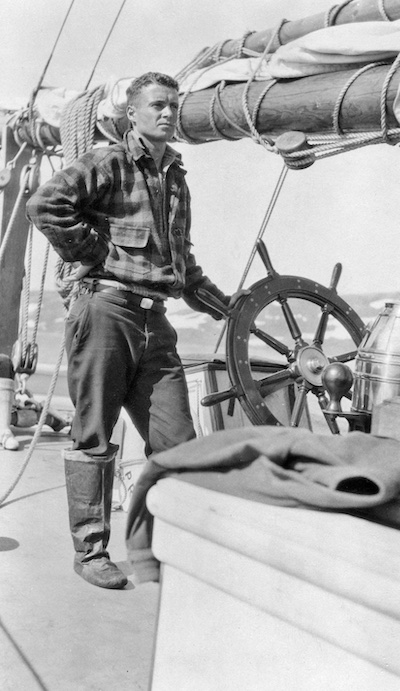
Jack Crowell at the wheel of the schooner Sachem, 1926. Photo by Paul Warren. From I Loved This Work…I have been delightfully busy, by John T. Crowell with Captain Jim Sharp and Spencer Apollonio (2010)
Used by permission from Penobscot Press, penbaypress.me
MacMillan had hired Captain John “Jack” Crowell to sail as master on the Thebaud, a vessel MacMillan had chartered for this expedition. Crowell was a seasoned ship's captain born and raised in Gloucester, Massachusetts. Crowell left high school for two years of training on the Ranger, a school ship, and then “tramped” on a number of ships to Central and South America and Europe before serving in the civilian part of the Navy in World War I, then enlisting and serving on the USS Westover, which was torpedoed and sunk on July 11, 1918.
After the war, he sailed on a variety of vessels, working his way up from third mate to second, finally making the time to apply for his master’s license. He wanted to “go north” and traveled to Boston to hear a lecture by MacMillan. In the summer of 1926, Crowell sailed for Greenland on the schooner Sachem, with MacMillan on the schooner Bowdoin, “in thick fog…dead reckoning all the time…with only a sketch of the coast of Greenland," with no sounding machines or information about the depth of the water. In 1927, Crowell engaged and fitted out the Radio, a fishing schooner, to carry provisions to the Arctic in late spring/early summer to support MacMillan’s yearlong expedition there. On this voyage, Crowell spent a great deal of time exploring Frobisher Bay. He also sailed on three other MacMillan expeditions in 1930 (Iceland), 1931 (Baffin Island), and 1934 (Labrador).
Thirty-five men came aboard the Thebaud for the expedition in 1937, including twenty-three students, several scientists, four crew members, two deckhands, and Crowell. Five of the men were Bowdoin students: Willard Streeter Bass ’38, John Ripley Forbes ’38, John Halford Jr. ’38, Peter Stengel ’39, and Ivan Spear ’44.
Unlike the Bowdoin, which was built for sailing in the Arctic, the Thebaud was built for the Gloucester fishing trade. The vessel was one of the last to be built at the Story Shipyard in Essex. If Crowell had known she was built from “shorts”—scraps of wood left over from building earlier boats—he never would have sailed her.
The Thebaud left Gloucester on the afternoon of June 24, 1937, stopping at several points along the Maine coast and working her way up the Novia Scotia coast in blinding fog, spending a few days in North Sydney. While the vessel was a sailing ship, Crowell used the Fairbanks Morris diesel engine to make better time, because the expedition needed to be completed in time for the students to return to their colleges in September.
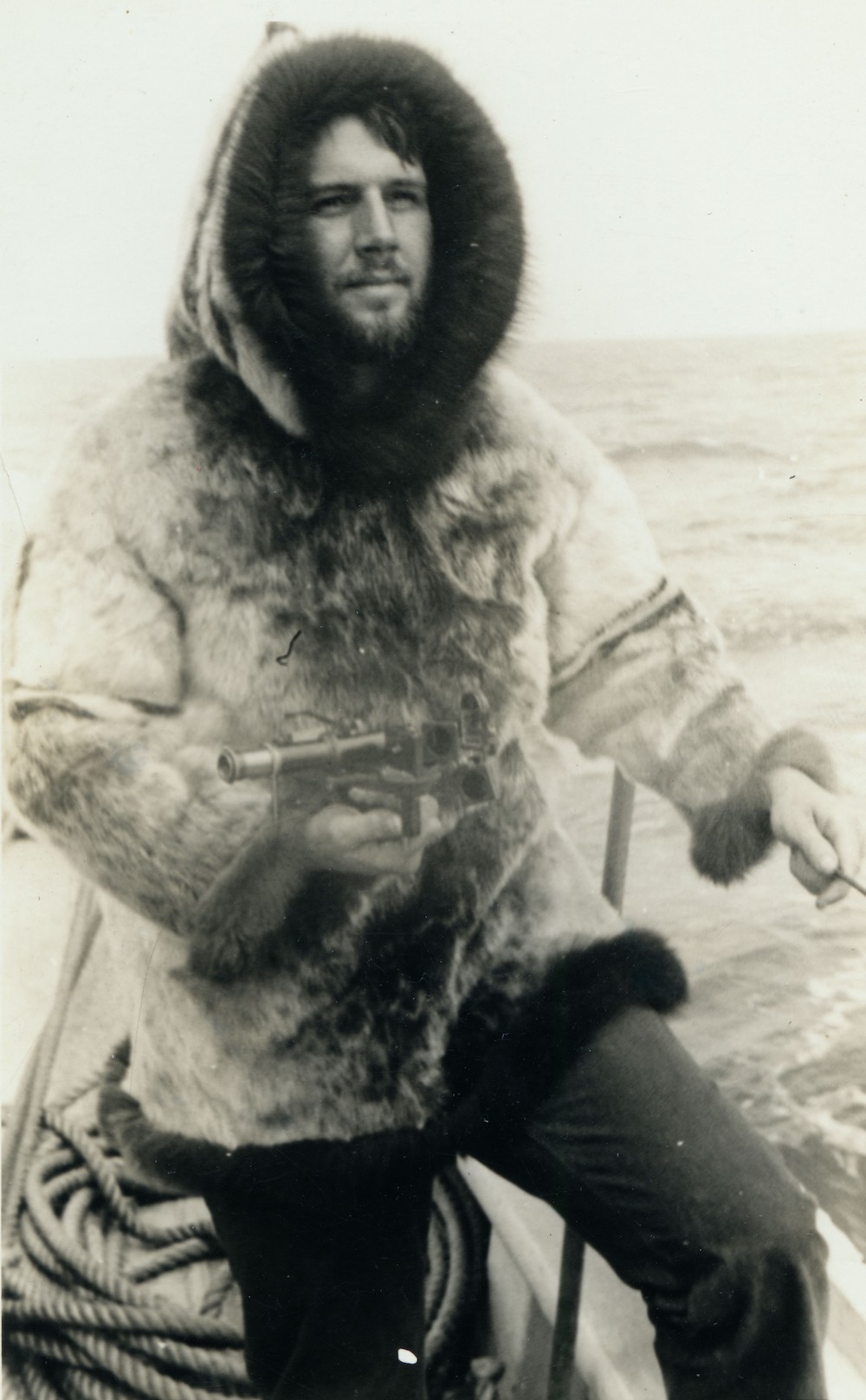
John Halford aboard the Thebaud wearing a sealskin jacket with a sextant, 1937.
Photo by Donald B. MacMillan. Gift of Donald and Miriam MacMillan. Peary-MacMillan Arctic Museum Collection.
By the Fourth of July, the ship was off the northern end of Newfoundland. They sailed past locations notorious for shipwrecks, seeing icebergs and “growlers,” dropping anchor in various harbors so the scientists and students could row to nearby islands to explore. They went ashore in Labrador at Hopedale and Nain and continued on their way toward Resolution Island and outer Frobisher Bay through thick fog, dodging pack ice and treacherous reefs. By July 28, the Thebaud was sailing along the southern coast of Frobisher Bay. The ship spent several days exploring the bay, and the students, scientists, and crew visited the shore, scaling 2,000-foot high cliffs to explore the Grinnell Glacier. Crowell found it hard to find a good anchorage given the depth of the water where the cliffs met the bay.
On the night of July 29, after difficulty finding an anchorage, they moored using a combination of anchor, kedge, and lines to the shore. Crowell felt the holding power “was questionable.” Everyone was exhausted from climbing the glacier, and Crowell decided to let all but one young man, who manned the deck, get some sleep—intending to stay moored there for only a few hours.
A few hours later, disaster struck. The breeze had picked up, and the Thebaud had turned broadside to the cliff. The tide was at its height and, as soon as Crowell was awakened by the watchman and stood up in his berth, he “could tell by the feel of the deck that she was already aground.”
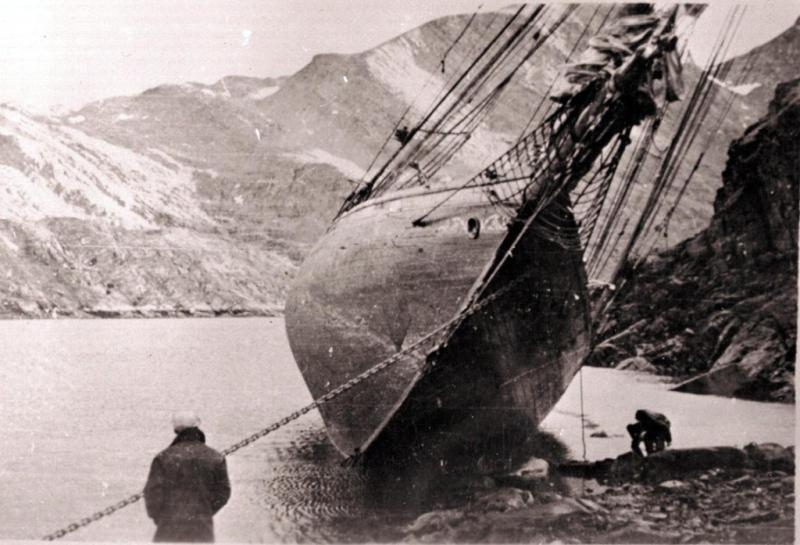
The Gertrude L. Thebaud in trouble in Frobisher Bay, Baffin Island 1937.
Unidentified photographer. Gift of Edward K. Morse. Peary-MacMillan Arctic Museum Collection
He knew with the twenty-six-foot tide dropping fast and her keel touching bottom that the ship would fall over. If she fell away from the cliffs, she’d go bottom up, and if she fell on the rocky shore, she might damage her bilge and not right herself on the next high tide.
The Thebaud did bilge herself, and Crowell discovered a large bulge in the ceiling in the botanist’s room on the port side of the ship. Although the ship was resting on a boulder, there was not a heavy cargo in the ship, so the boulder was not the reason for the ceiling planks to be spreading apart. One of the crew pointed out that the deck planking had separated from the covering board at the waterways. The ship was slowly spreading apart.
Crowell’s autobiography, I Loved This Work… I have been delightfully busy (Penobscot Books, 2010), is riveting in describing how the rising tide filled the vessel until it was nearly full of water. And then, “quite suddenly but easily the old girl began to right herself … and the sea ran in the scuppers across the deck and out the other side.” The anchor was hauled and the ship was moved away from the beach by hauling on the kedge warp and the quarter lines to the cliff using the motorboat they had with them for the expedition. The ship’s engine, cookstove, and almost all the stores, bunks, and bedding were underwater. They had no powered pumps but did have two hand-operated deck pumps, along with some ten-gallon cans and thirty-five people, who began to bail water using anything they could lay their hands on. Crowell said the college students were all in good shape and “were as scared as I was.” Time passed and it seemed that they were gaining on the situation. Unbelievably, they were able to bail the vessel out and miraculously, the Thebaud stopped leaking. They sailed further out in the bay and began to haul bedding and clothing and stores onto the deck to dry out. The chief and two students went to the engine room and surprisingly were able to get it going. Crowell wanted to sail back to home port with the vessel but MacMillan wanted to live up to his promise to the “boys” to get to the Arctic Circle. Crowell agreed to try and they got quite close before pack ice forced them to turn around.
Crowell sailed to Bar Harbor, where the damage to the vessel was reported to the ship’s owner and then it was sailed to its home port. Those who sailed on the Thebaud that summer had studied the geography of Resolution Island, explored the Baffin Island ice caps and other land masses, collected extensive samples of Arctic flora and bird skins, and survived a near shipwreck—living to tell the tale.
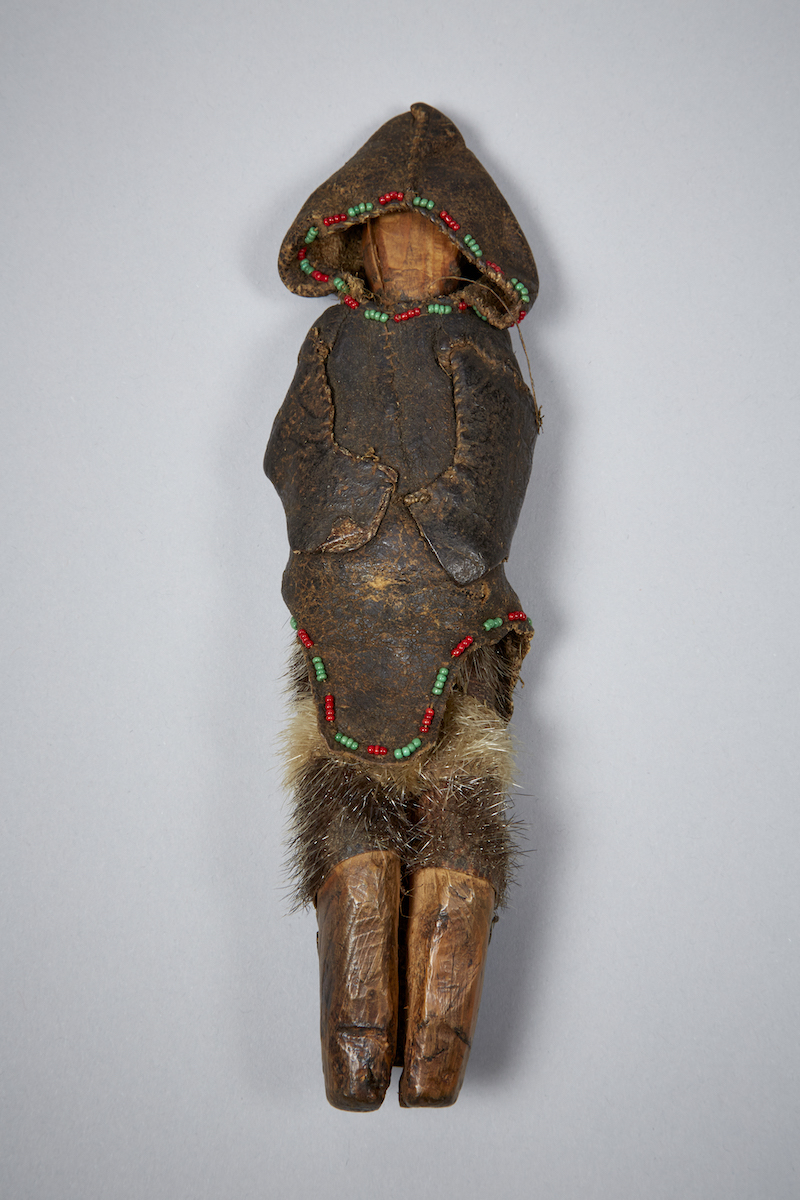
Unidentified Inuk Artist, Doll.
Gift of John Halford, Jr. ’38
Peary-MacMillan Arctic Museum Collection
In the years that followed, many of the Bowdoin students who were on the Thebaud gifted artifacts from that voyage to the Peary-MacMillan Arctic Museum collection. Peter Stengel ’39 donated artifacts from Kodlunarn Island and a sounding lead and line from the Thebaud. One item donated by John Halford Jr. ’38, P’64, an Inuit doll, is a special favorite of the museum staff.
Halford was very generous to the College and, like his father, John Sr., Class of 1907, a supporter of the Bowdoin College Museum of Art. John Jr. and his wife, Laura, established a life income gift shortly before members of the sixteenth expedition convened on Bowdoin’s campus in June 1987 to celebrate the fiftieth anniversary of their Arctic voyage. Per their instructions, when John and Laura passed on, the remaining value of their life income gift was used to establish an endowed fund in their names to support the acquisition of art for the Bowdoin College Museum of Art.
Like John Halford, W. Streeter Bass ’38, P’76 established a life income gift and designated the remainder value to the W. S. Bass ’96 (1896) and J. R. Bass ’00 (1900) Scholarship Fund. Ivan Spear ’44 left a bequest to establish the Roy B. Spear Memorial Fund in memory of his father, Class of 1919, to support the Bowdoin Scientific Station at Kent Island.
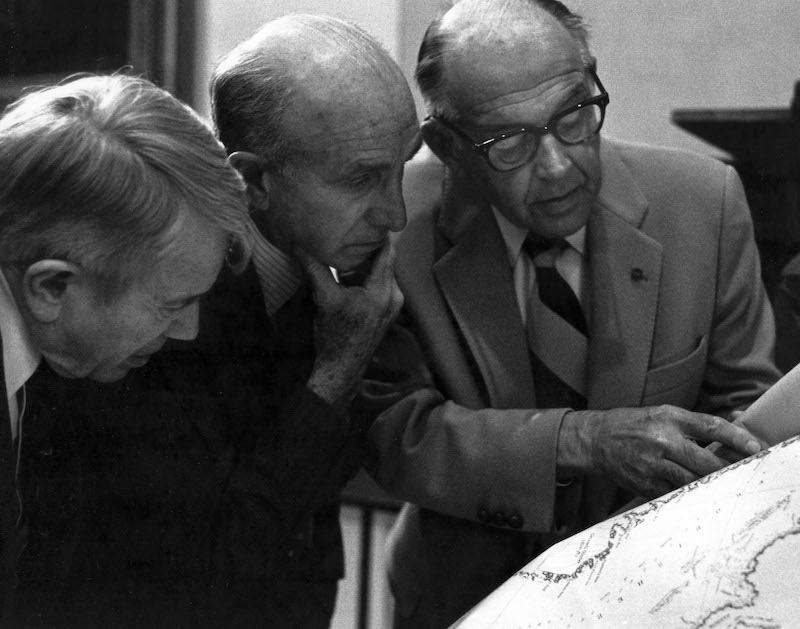
L to R: Dr. Martin Buerger, Charles Edwards, and John Halford Jr. on campus in 1987 for the fiftieth anniversary of their Arctic expedition
Photo by James Staples. Peary-MacMillan Arctic Museum Collection
John Ripley Forbes ’38, H’87 did not graduate from Bowdoin. He had been admitted as a special student for the 1934–1935 academic year to study ornithology with Bowdoin professor Alfred Gross, who joined in the expedition for a few weeks. Forbes served as the ornithologist on the expedition. During his lifetime, he was renowned as a naturalist and founded or organized more than two hundred natural science centers and museums. He was awarded an honorary degree from Bowdoin College in 1987.
Jack Crowell’s experience in the Arctic made him a “go-to guy” for the US military leading up to and during World War II, as well as afterward. He worked to establish weather stations and airfields throughout the Arctic. In the 1960s, his focus shifted to the Antarctic, working with the National Science Foundation’s Antarctic Project Office, which was interested in establishing both a land base and a ship-based oceanographic research program. In retirement, Jack and his wife, Alice, lived on Kimball Island off of Isle au Haut in Penobscot Bay, where they lobstered. On their fiftieth wedding anniversary, a party of friends sailed the schooner Bowdoin to Kimball Island to celebrate with them. Alice passed away on the island at Christmastime in 1984, and Jack followed her to his rest on April 25, 1986.
Credits: Donald and Miriam MacMillan Collection, George J. Mitchell Department of Special Collections & Archives, Bowdoin College Library, Brunswick, Maine; Peary-MacMillan Arctic Museum Collection, Bowdoin College, Brunswick, Maine; and, I Loved This Work…I have been delightfully busy, by John T. Crowell with Captain Jim Sharp and Spencer Apollonio (2010) published by Penobscot Books, a division of Penobscot Bay Press.